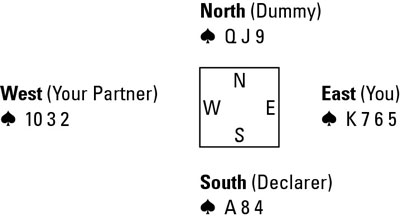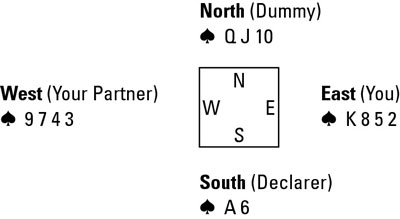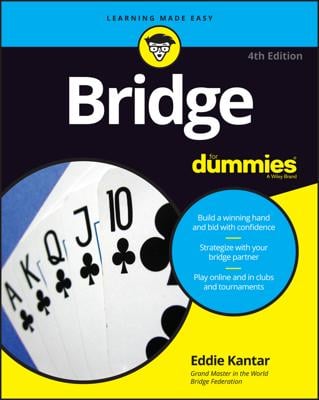Following a low lead with a low card
When the dummy leads a low card, you normally play the lowest card you have, which is called playing second hand low.You can play second hand low most of the time. In fact, it is an exception not to play second hand low when the dummy leads a low card. You don’t give away any secrets when you play second hand low.
Exceptions to playing low occur if you have a sequence of three or more equal cards headed by an honor, such as the QJ104 or the J1098. If you do, play your highest equal, the same card you’d have led had you been on lead. Your partner now has a readout as to what you have in the suit.
Covering an honor with a higher honor
When the dummy leads an honor card (10 or higher) and you have a higher honor card, gently place your honor right on top of the dummy’s honor. By so doing, you force the declarer to play yet another honor to that trick. After at least three honor cards are played to the same trick, lower spot cards have a way of becoming winning tricks; it’s called promotion — the reason you cover.If you cover an honor with an honor and the declarer takes the trick with yet another honor, three of the top five honors vanish on one trick. Suddenly the lower honors, and the eights and nines, sit up and take notice because they soon become winning tricks. You cover an honor with an honor to promote lower honors (not to mention eights and nines) for either you or your partner.
Covering the last of equal honors in the dummy
When the dummy leads one of several equal (consecutive) honors, don’t cover the first honor; instead, cover the last equal honor. For example, if the dummy has two equal honors, such as the QJ6 or the J103, cover the second honor led. If the dummy has three equal honors, such as the QJ10 or the J109, cover the last equal led from the dummy. Here’s why:-
When the dummy has two equal honors: In this image, the dummy has two equal honors. Which one should you cover? If either honor (♠Q or ♠J) is led from the dummy, play low. When the second honor is then led from the dummy, cover that one with your ♠K. Even though your ♠K loses to the ♠A, your partner’s ♠10 becomes the highest remaining spade. If you cover the first honor, the declarer wins the ♠A and can lead a low spade, finessing the dummy’s ♠9 and taking all three tricks.

-
When the dummy has three equal honors: This image gives you a look at a dummy that has three equal honors. Whichever honor is led from the dummy, say the ♠Q, don’t cover. When a second honor is played, don’t cover again. Now you can see how your patience pays off. If you play low twice, the declarer takes the first trick with the ♠Q and the second trick with the ♠A, and winds up taking only two spade tricks. If you mistakenly cover the first or second honor, the declarer takes three tricks because dummy’s remaining spade is a winning trick.


